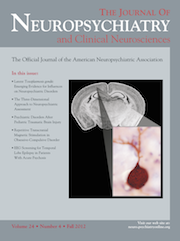Olanzapine-Associated Priapism
To the Editor: Priapism is defined as painful, persistent, and prolonged penile erection. It has been associated with long-term devastating consequences such as impotence, gangrene, and urinary retention. Psychotropic medication, notably, trazodone, is well known for its side effect of priapism; however, antipsychotic medications have also been reported to cause priapism.1
A 24-year-old African American man with a history of bipolar disorder presented with a severe manic episode associated with psychotic symptoms. He was on valproic acid with good results in the past, however had been noncompliant with his medication for 2 weeks prior to his presentation. He denied any substance use, and his urine toxicology screen was negative. There were no concomitant medical problems, and home medication list was restricted to valproic acid. The patient was hospitalized, and valproic acid was resumed. Olanzapine 5 mg at bedtime was started as an augmentation agent for his severe manic episode. On the mornings of Day 3 and 4 of hospital stay, the patient complained of prolonged, painless erection not associated with any sexual behavior or thoughts. These episodes lasted for around 30 minutes and resolved without any intervention. However, on Day 5, the erection was painful and did not resolve up to 2 hours after the patient woke up in the morning. The urology service was consulted and immediate evacuation of blood from the patient’s penis was performed and phenylephrine was injected, achieving complete flaccidity. The Naranjo algorithm determined a probable association between olanzapine and priapism.2 Olanzapine was discontinued, and the patient was continued on valproic acid. He stabilized with regard to his mood disorder in the next 3 days and did not have a recurrence in the symptoms of prolonged erections. Olanzapine was documented in the medical records to cause this adverse reaction and was never administered in the future. The patient has not had recurrence of priapism in the next 2 years after his initial episode.
Priapism results from alpha1-adrenergic blockade in the corpora cavernosa, leading to a parasympathetic-mediated arteriodilation, as well as inhibition of the sympathetic system that leads to detumescence. This leads to an intracavernosal stasis, owing to inadequate venous outflow caused by the obstruction of subtunical venules, resulting in hypoxia, acidosis, and pain.3 Alpha2-adrenergic blockade exacerbates the priapism by stimulating the release of a nitric oxide-like substance, which further stimulates erections.4 Antipsychotic-induced priapism has been linked to the alpha1-adrenergic antagonism of these medications. Olanzapine has both alpha1- and alpha2-blocking characteristics and has been associated with several similar cases.1 Clinicians prescribing antipsychotics should be aware and educate patients about this rare but serious adverse reaction of these medications.
1 : Priapism associated with atypical antipsychotic medications: a review. Int Clin Psychopharmacol 2008; 23:9–17Crossref, Medline, Google Scholar
2 : A method for estimating the probability of adverse drug reactions. Clin Pharmacol Ther 1981; 30:239–245Crossref, Medline, Google Scholar
3 : Effects of psychotropic drugs on human erection and ejaculation. Arch Gen Psychiatry 1989; 46:275–284Crossref, Medline, Google Scholar
4 : Olanzapine-induced reversible priapism: a case report. J Clin Psychopharmacol 1998; 18:351–353Crossref, Medline, Google Scholar



